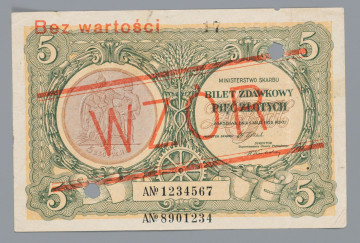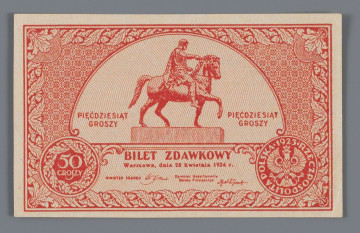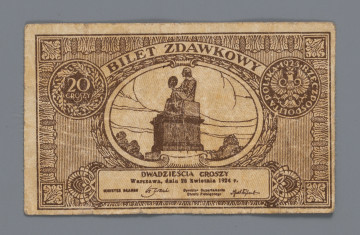
5 zlotys – a template
1925
National Museum in Lublin
Part of the collection: Paper money during the Second Polish Republic
In the history of Polish money there were many periods when substitute money was introduced into circulation. Most often it happened in times of economic problems or attempts to overcome them. One of such periods came in 1924, with the implementation of the economic reform, later known as the Władysław Grabski Plan. One of the elements of this plan was a currency reform consisting in the introduction of the złoty in place of the Polish mark, combined with denomination. The accelerated pace of change resulted in difficulties in introducing into circulation mainly złoty coins. As a result, a temporary countermeasure was introduced, consisting in the issuance of the so-called treasury notes, i.e. paper money substitutes. The first treasury notes were put into circulation together with Władysław Grabski's reform, as of 28 April 1924. These were, on the one hand, one- and two-zloty banknotes, which had been stored for five years and had been printed in 1919, which were put into circulation in a changed role. On the other hand, halves of the old 500,000- and 10,000,000 Polish mark banknotes were used, with new red markings informing that they served as 1 and 5 groszy treasury notes. Finally, specially prepared notes of 10, 20 and 50 groszy were printed. Despite the remedial measures taken in 1925, the shortage of coins was still strongly felt on the market. Therefore, the Ministry of Finance, with the consent of the Sejm, prepared the issue of new notes with the value of 2 and 5 złotys. In both cases the graphic design was prepared by Wacław Borowski, a painter and graphic artist, a leading representative of the so-called New Classicism. Since the substitute money did not inspire public confidence, the images of the replaced coins were placed on the obverses of both notes. Two-złoty notes went into circulation on 30 May 1925 and remained in circulation until 31 March 1928, although the final date for exchange was 31 March 1930.
The presented specimen of the two-złoty note had typical markings that were also used on other types of treasury notes and banknotes. These were two diagonal red lines on both the obverse and the reverse and a red “No value” inscription in the upper right part of both sides of the note. Some specimens had 2 holes approximately 5 mm in diameter.
Leszek Poniewozik
Author / creator
Dimensions
cały obiekt: height: 115 mm, width: 80 mm
Object type
paper money
Technique
Material
paper
Creation time / dating
Creation / finding place
Owner
The National Museum in Lublin
Identification number
Location / status

1925
National Museum in Lublin

1924
National Museum in Lublin

1924
National Museum in Lublin
DISCOVER this TOPIC
National Museum in Lublin
DISCOVER this PATH
Educational path